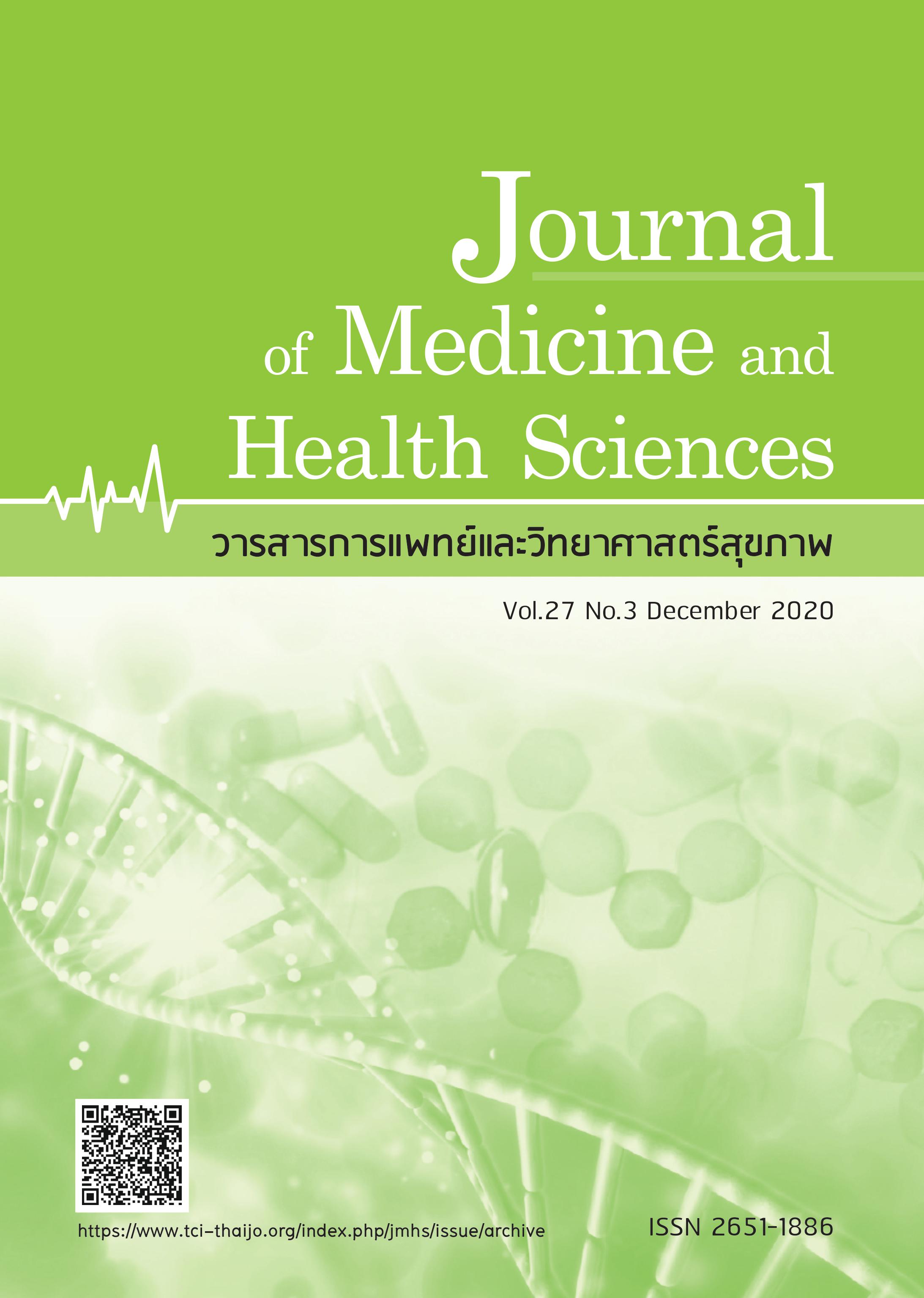ผลของสารสกัดจากใบมะรุมต่อการต้านเซลล์มะเร็ง squamous cell carcinoma 15
คำสำคัญ:
มะรุม, เซลล์มะเร็ง SCC15, การตายแบบอะพอพโทซิสบทคัดย่อ
บทคัดย่อ
มะรุม (Moringa oleifera Lam.) เป็นพืชสมุนไพรที่นิยมเพาะปลูกสำหรับใช้เป็นอาหาร นอกจากนี้มะรุมยังมีฤทธิ์ต้านการอักเสบ ต้านสารอนุมูลอิสระ ต้านเชื้อแบคทีเรีย และต้านมะเร็ง ซึ่งโรคมะเร็งเป็นสาเหตุ การเสียชีวิตอันดับหนึ่งของคนไทย ได้แก่ มะเร็งปอด มะเร็งตับ มะเร็งเต้านม และมะเร็งศีรษะและคอ งานวิจัยนี้ คณะผู้วิจัยสนใจศึกษาฤทธิ์การต้านมะเร็งของสารสกัดจากใบมะรุมต่อเซลล์มะเร็งศีรษะและคอ (squamous cell carcinoma 15: SCC15 cells) โดยนำสารสกัดจากใบมะรุมที่สกัดด้วย hexane (crude hexane) ทดสอบความเป็นพิษกับเซลล์มะเร็ง SCC15 และเซลล์แมคโครฟาจของคน จากนั้นเลือกใช้ความเข้มข้นของสารสกัดที่ไม่เป็นพิษกับเซลล์แมคโครฟาจของคนคือระดับความเข้มข้นที่ทำให้เซลล์แมคโครฟาจตายเพียงร้อยละ 5 (IC5) และนำมาทดสอบกับเซลล์มะเร็ง SCC15 เพื่อศึกษาคุณสมบัติของสารสกัดที่ส่งผลต่อการตายของเซลล์มะเร็ง SCC15 โดยตรวจวิเคราะห์การตายแบบอะพอพโทซิสด้วยชุดทดสอบ Muse™ Annexin V & Dead Cell Kit ผลการตรวจวิเคราะห์พบว่า สารสกัดจากใบมะรุมสามารถชักนำให้เซลล์มะเร็งเกิดการตายแบบอะพอพโทซิส เพิ่มขึ้นอย่างมีนัยสำคัญทางสถิติ (p<0.05) เช่นเดียวกับยาซิสพลาติน เมื่อเปรียบเทียบกับชุดควบคุม จากผลการศึกษาสรุปได้ว่าสารสกัดจากใบมะรุมมีคุณสมบัติต้านเซลล์มะเร็ง SCC15 โดยทำให้เกิดการตายของเซลล์มะเร็งดังกล่าวแบบอะพอพโทซิส ซึ่งจากผลการวิจัยนี้ยังไม่ทราบว่าในสารสกัดมีสารออกฤทธิ์ชนิดใดที่มีคุณสมบัติ ต้านเซลล์มะเร็ง ดังนั้น ควรมีการศึกษาหาสารออกฤทธิ์ในสารสกัดจากใบมะรุมและศึกษากลไกการต้านมะเร็งเพื่อนำความรู้ไปพัฒนายารักษาโรคมะเร็งศีรษะและคอต่อไป
References
2. Aggarwal BB , Surh YJ, Shishodia S, editors. The molecular targets and therapeutic uses of curcumin in health and disease. New York: Springerlink; 2007.
3. Kang Zi Khor, Vuanghao Lim, Emmanuel J Moses, et al. The in vitro and in vivo anticancer properties of Moringa oleifera. Evid Based Complement Alternat Med
2018;14:1071-243.
4. Al-Asmari AK, Albalawi SM, Athar MT, et al. Moringa oleifera as an anti-cancer agent against breast and colorectal cancer cell lines. PloS one 2015;10:814.
5. Minirtry of Public health. Public health statistic A.D. 2017. Nontaburi: Minirtry of Public health; 2018.
6. Ferlay J EM, Lam F, Colombot M, et al. Bray F Global cancer observatory: Cancer today Lyon, France. International Agency for Research on Cancer 2018. [Internet].
2018 May [cited 2019 May 10]. Available form: http://goc.iarc.fr/today/fact-sheetspopulations.
7. Hashibe M, Brennan P, Benhamou S, et al. Alcohol drinking in never users of tobacco, cigarette smoking in never drinkers, and the risk of head and neck cancer: Pooled
analysis in the International head and neck cancer epidemiology consortium. J Natl Cancer Inst 2007;99:777-89.
8. Cristiana Lo Nigro, Nerina Denaro,Anna Merlotti, et al. Head and neck cancer: improving outcomes with a multidisciplinary approach. Cancer Manag Res 2017;9:363-71.
9. Wyss A, Hashibe M, Chuang S-C, et al. Cigarette, cigar, and pipe smoking and the risk of head and neck cancers: pooled analysis in the International head and neck cancer epidemiology consortium. Am J Epidemiol 2013;178:679-90.
10. Cancer Institute NSW Australian Technology Park: Cancer Institute NSW. Cancer treatment side effects: A guide for Aboriginal Health Workers. Cancer
Institute NSW; 2015.
11. Jung IL. Soluble extract from Moringa oleifera leaves with a new anticancer activity. PloS one 2014;9:954-92.
12. Li Q, Wen J, Yu K, et al. Aloe-emodin induces apoptosis in human oral squamous cell carcinoma SCC15 cells. BMC Complement Altern Med 2018;18:296.


